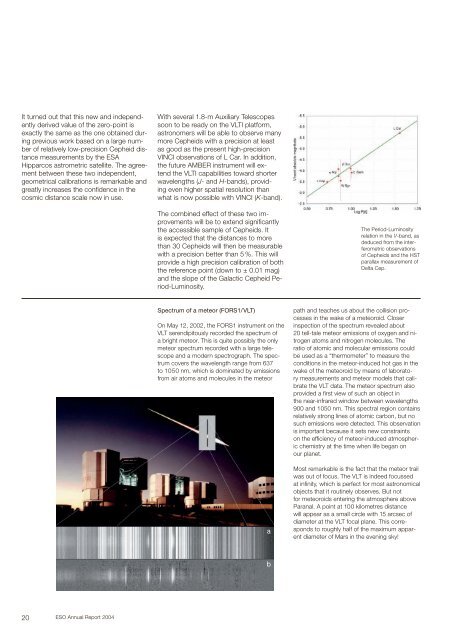ESO Annual Report 2004
ESO Annual Report 2004
ESO Annual Report 2004
- TAGS
- annual
- www.eso.org
Create successful ePaper yourself
Turn your PDF publications into a flip-book with our unique Google optimized e-Paper software.
It turned out that this new and independently<br />
derived value of the zero-point is<br />
exactly the same as the one obtained during<br />
previous work based on a large number<br />
of relatively low-precision Cepheid distance<br />
measurements by the ESA<br />
Hipparcos astrometric satellite. The agreement<br />
between these two independent,<br />
geometrical calibrations is remarkable and<br />
greatly increases the confidence in the<br />
cosmic distance scale now in use.<br />
20<br />
<strong>ESO</strong> <strong>Annual</strong> <strong>Report</strong> <strong>2004</strong><br />
With several 1.8-m Auxiliary Telescopes<br />
soon to be ready on the VLTI platform,<br />
astronomers will be able to observe many<br />
more Cepheids with a precision at least<br />
as good as the present high-precision<br />
VINCI observations of L Car. In addition,<br />
the future AMBER instrument will extend<br />
the VLTI capabilities toward shorter<br />
wavelengths (J- and H-bands), providing<br />
even higher spatial resolution than<br />
what is now possible with VINCI (K-band).<br />
The combined effect of these two improvements<br />
will be to extend significantly<br />
the accessible sample of Cepheids. It<br />
is expected that the distances to more<br />
than 30 Cepheids will then be measurable<br />
with a precision better than 5 %. This will<br />
provide a high precision calibration of both<br />
the reference point (down to ± 0.01 mag)<br />
and the slope of the Galactic Cepheid Period-Luminosity.<br />
Spectrum of a meteor (FORS1/VLT)<br />
On May 12, 2002, the FORS1 instrument on the<br />
VLT serendipitously recorded the spectrum of<br />
a bright meteor. This is quite possibly the only<br />
meteor spectrum recorded with a large telescope<br />
and a modern spectrograph. The spectrum<br />
covers the wavelength range from 637<br />
to 1050 nm, which is dominated by emissions<br />
from air atoms and molecules in the meteor<br />
a<br />
b<br />
The Period-Luminosity<br />
relation in the V-band, as<br />
deduced from the interferometric<br />
observations<br />
of Cepheids and the HST<br />
parallax measurement of<br />
Delta Cep.<br />
path and teaches us about the collision processes<br />
in the wake of a meteoroid. Closer<br />
inspection of the spectrum revealed about<br />
20 tell-tale meteor emissions of oxygen and nitrogen<br />
atoms and nitrogen molecules. The<br />
ratio of atomic and molecular emissions could<br />
be used as a “thermometer” to measure the<br />
conditions in the meteor-induced hot gas in the<br />
wake of the meteoroid by means of laboratory<br />
measurements and meteor models that calibrate<br />
the VLT data. The meteor spectrum also<br />
provided a first view of such an object in<br />
the near-infrared window between wavelengths<br />
900 and 1050 nm. This spectral region contains<br />
relatively strong lines of atomic carbon, but no<br />
such emissions were detected. This observation<br />
is important because it sets new constraints<br />
on the efficiency of meteor-induced atmospheric<br />
chemistry at the time when life began on<br />
our planet.<br />
Most remarkable is the fact that the meteor trail<br />
was out of focus. The VLT is indeed focussed<br />
at infinity, which is perfect for most astronomical<br />
objects that it routinely observes. But not<br />
for meteoroids entering the atmosphere above<br />
Paranal. A point at 100 kilometres distance<br />
will appear as a small circle with 15 arcsec of<br />
diameter at the VLT focal plane. This corresponds<br />
to roughly half of the maximum apparent<br />
diameter of Mars in the evening sky!

















